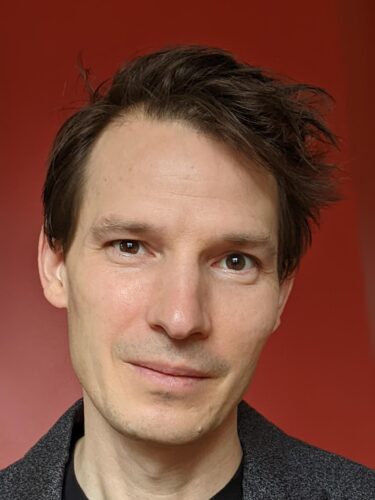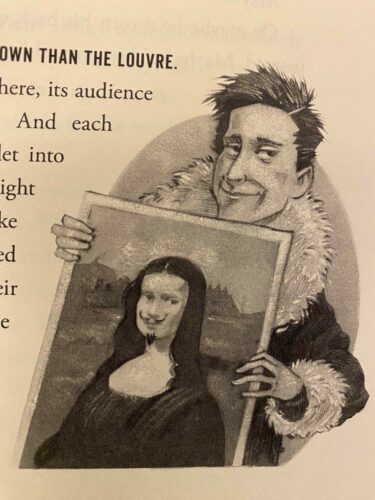Heists, Celebrity, and Mystery: An Interview with Nicholas Day About The Mona Lisa Vanishes
It was Memorial Day weekend and I was throwing a slew of new books into my bag to read on the drive up to the Wisconsin Dells. In the course of doing so, one particular cover caught my eye. This cover, to be exact:

Intriguing, no? I had this vague sense that I already knew this story, but figured it couldn’t hurt to give the book a read for a few pages.
Next thing I know I’m hurtling down the highway, engrossed in the storytelling of Nicolas Day, while yelling random facts at my kids in the backseat about Leonardo da Vinci, the Louvre, fictional detectives (and thieves!), and why Picasso was THE WORST. When I got back home I absolutely had to talk to this author about this book. After all, what we have here is a work of narrative nonfiction that will completely suck in child readers. Here’s its description:
ADVERTISEMENT
ADVERTISEMENT
“On a hot August day in Paris, just over a century ago, a desperate guard burst into the office of the director of the Louvre and shouted, La Joconde, c’est partie! The Mona Lisa, she’s gone!
No one knew who was behind the heist. Was it an international gang of thieves? Was it an art-hungry American millionaire? Was it the young Spanish painter Pablo Picasso, who was about to remake the very art of painting?
Travel back to an extraordinary period of revolutionary change: turn-of-the-century Paris. Walk its backstreets. Meet the infamous thieves—and detectives—of the era. And then slip back further in time and follow Leonardo da Vinci, painter of the Mona Lisa, through his dazzling, wondrously weird life. Discover the secret at the heart of the Mona Lisa—the most famous painting in the world should never have existed at all.
Here is a middle-grade nonfiction, with black-and-white illustrations by Brett Helquist throughout, written at the pace of a thriller, shot through with stories of crime and celebrity, genius and beauty.”
And happily, Mr. Day himself was willing to answer some of my questions:
Betsy Bird: Nick! Thanks so much for joining me and being so willing to talk about THE MONA LISA VANISHES. I picked up that book and next thing I knew I’d practically downed the whole thing in one sitting. I’ve no doubt that kids will do the same. But just to start us off, let’s discuss how you got started with this project. I know that you wrote the title BABY MEETS WORLD for adults, but writing narrative nonfiction about infants doesn’t always naturally lend itself to heist-related middle grade titles. Where did MONA LISA come from?

Photo Credit: Isaiah Day
Nicolas Day: Betsy! Thank you for sharing your stage and I am delighted that you liked the book. I have no idea where I ran across the fact that the Mona Lisa had been stolen, but I absolutely remember thinking: Now this is a story. And the more I learned about the heist, the more intrigued I was. The heist was extraordinary, the characters were weird and wonderful, Leonardo da Vinci was, well, Leonardo da Vinci, who was always extraordinary and weird and wonderful. And the story had a striking, unexpected contemporary resonance. The Mona Lisa theft was very much not the perfect crime, but it was sort of the perfect story. I am duly grateful to that mysterious, white-smocked man in the closet of the Louvre.
BB: Ah, yes. The one who helped to give you that killer opening scene. You know, the term “narrative nonfiction” is a relatively new one in the popular lexicon, but I can’t think of a better way to describe what it is that you do in this book. This book is ridiculously engaging and a great deal of that heavy lifting is due to this voice and style you employ from the get-go. I hate to ask this, but I sort of have to. How did you get the voice for this narration down?
ND: This is a wonderful question, and it brings us around to why I wanted to write for younger readers. We’ve seen so much wonderful nonfiction for children lately, and I think there’s still a lot of space for new ways of telling these stories (for whatever age). Voice isn’t a new way, of course, but it is a tool that I think is sometimes underutilized in nonfiction for younger readers. Maybe this is a legacy of the informational origins of nonfiction for children. There can be more focus on the thing—the American Revolution, the warty cane toad, what have you—and less on the telling of the thing. But the telling is what matters. It’s what draws in the reader. Maybe that sounds like authorial narcissism. (My telling matters more than the facts of the American Revolution!) But we all know this is true for fiction: the plot summary is worth nothing; the story is what matters. It’s not wild to think that’s true for nonfiction too. It’s sort of wild to think that it wouldn’t be. We can have the story and the educational content. We can have it all!
As for this specific narration: I mean, who knows? I think that’s all experiment, as you well know, Betsy. Talk it out, see what works, scrap the rest. The story is so strong here that the voice could be relatively light, resting on the twin pillars of the theft and Leonardo.
BB: Well, right! I mean, the crux of the book lies in how you break the narrative into those two parts: On the one hand you have the heist and its investigation, and on the other you’ve the life of Leonardo. Was this always the format you planned to have or did it come later in the writing process?
ND: Absolutely planned, for wholly selfish reasons: both storylines were so good I was reluctant to give up either. The problem was always: Would it work? I think the key here was tense. Once I started using different tenses for each story—present for Leonardo, past for the theft—the book seemed to snap together.

BB: You adeptly manage to make the book quite the contemporary comment on society when you show how assumptions and conspiracy theories relate to the world we live in today. This comes later on in the book, but I appreciated the ways in which you backed up and made this story about more than just How-the- Mona-Lisa-Got-Famous. When writing the book, was the intention from the start to make that final connection? Did it come up naturally in the writing process? Was it suggested by your editor?
ND: This was a delicate process. I did not want this to be the point of the story. This isn’t a didactic book. (Heaven forfend.) I wanted it to be something that echoed after the book was over, giving the story a resonance with, you know, how we live now. So it had to be light. It had to organically build over the course of the book, so that when you get to the end—and to the part where I let myself be a bit more explicit—it feels natural, an obvious connection, like something the reader has intuited before it even comes up. The connection itself came up over the course of the research. At least for me, ideas like this come up in the course of reading and thinking, and then—without you even being aware of it—they begin to feel inevitable.
BB: Maybe I’m just not remembering clearly enough, but I’m pretty certain I’ve never seen Brett Helquist illustrate a work of nonfiction before. Did you always envision the book as having illustrations or did the idea come up later? And what do you think of Helquist’s spot art? The man does a pretty good Picasso, I must say.
ND: I cannot imagine the book without Brett’s drawings. (Well, I can, and it looks very boring.) I was thrilled when he agreed to illustrate it. His style suits the time—both times—perfectly. The original idea here came from my agent, Brenda Bowen, who saw the potential pretty much as soon as she read the manuscript, as far as I can tell. She’s brilliant, the idea was brilliant: no photos, no captions, we’re signaling that this is a story. And then Ann Kelley, my wonderful editor at Random House Studio, took the idea and ran with it and somehow produced this exquisite book. How, I’ll never know.
ADVERTISEMENT
ADVERTISEMENT
BB: Odds are, you had other stories, other people, that you initially would have liked to have included in this book. Time constraints and editing would have meant casting them aside. Are there any particular stories, anecdotes, or characters you wish you could have included in the book, regardless of how useful they were to the narrative flow?

ND: There are so many books inside this book. It’s an almost bottomless well of material. (Once Random House approves the director’s cut, that’s when we’ll see it all.) It is so hard to stop writing about Leonardo—everything is interesting. (His notebooks!) And turn-of-the-century Paris is equally compelling. There’s so much happening! I wanted to write a book of the birth of modernism; I wanted to write a book about the birth of policing; I wanted to write a book about the new understandings of time and space. I was really sort of spoiled for choice, which made choosing all the more agonizing, of course.
BB: Finally, can we hope for more books of this sort from you in the future?
ND: Yes! Neal Porter is publishing a picture book of mine, Nothing, with Chris Raschka illustrating. (Chris Raschka!) It’s about the composer John Cage, his famous “silent” composition, and how much something there is in nothing. That’s out next spring. And then in 2025, there’s a new book of narrative nonfiction with Random House Studio and Ann Kelley. It’s about the Year without Summer, which was the aftermath of a volcanic eruption a couple of centuries ago. It’s the story of a climate shock—a sudden, terrifying shift in the seasons. I wish it did not have so much to say to us today.
If you’d like to read this amazing book for yourself, you’ll find it on bookstore and library shelves everywhere September 5th. Loads of thanks to Nicholas Day for answering my questions and to Annie Kelley and the folks at Penguin Random House for arranging this talk. Special credit too to book jacket designer Katrina Damkoehler for her work on this cover. Now go and put this book on reserve!
Filed under: Best Books, Best Books of 2023, Interviews
About Betsy Bird
Betsy Bird is currently the Collection Development Manager of the Evanston Public Library system and a former Materials Specialist for New York Public Library. She has served on Newbery, written for Horn Book, and has done other lovely little things that she'd love to tell you about but that she's sure you'd find more interesting to hear of in person. Her opinions are her own and do not reflect those of EPL, SLJ, or any of the other acronyms you might be able to name. Follow her on Twitter: @fuseeight.
ADVERTISEMENT
ADVERTISEMENT
SLJ Blog Network
Endangered Series #30: Nancy Drew
Cat Out of Water | Review
Navigating the High School and Academic Library Policy Landscape Around Dual Enrollment Students
MakerSpace: Dipping My Toes into Sublimation 101
ADVERTISEMENT







